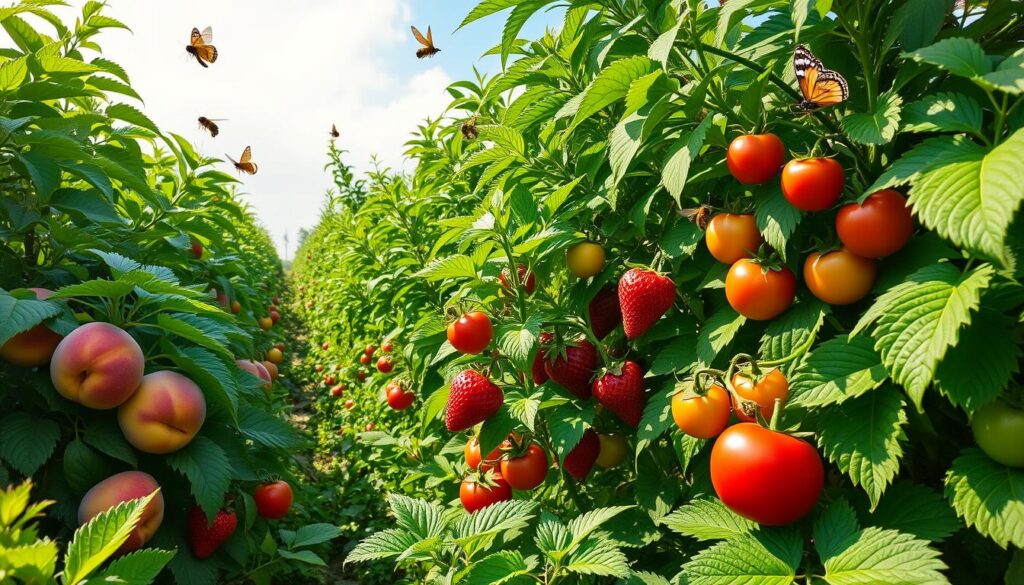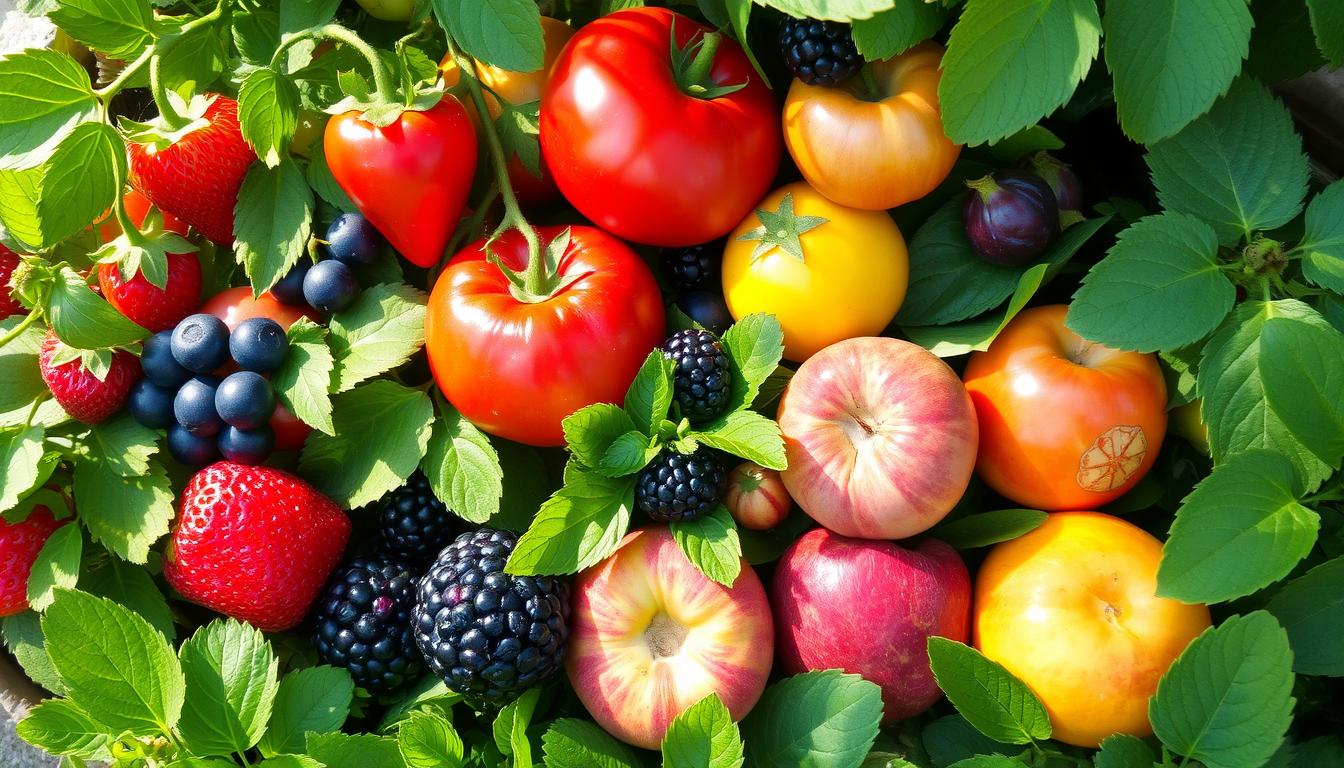If you’re new to gardening and want to grow fruits, you’re in the right spot. I’ll share my top picks for easy fruits to grow for beginners. These fruits are perfect for those starting out in fruit gardening. They need little effort but offer big rewards in taste and enjoyment.
Imagine picking fresh strawberries or raspberries from your garden. That’s what I want to help you achieve. My choices are not only tasty but also easy to grow. They’ll help you grow confident as a gardener. For more tips on gardening, check out this resource.
Key Takeaways
- Fruits chosen are perfect for beginner gardeners.
- Each fruit promises minimal effort with substantial returns.
- Homegrown fruits can enhance your culinary experiences.
- The journey into fruit gardening can be both enjoyable and educational.
- Consider your space and light conditions when selecting plants.
Introduction to Fruit Gardening for Beginners
Fruit gardening connects us to nature, making it perfect for beginners. It’s easy to grow your own fruits at home with the right approach. Knowing how to water, where to place your plants, and how much space they need is key.
Starting out in fruit gardening can be tough, but the joy of harvesting your own fruits makes it worth it. Simple steps can turn any space into a fruitful paradise. This novice fruit growing guide helps you overcome common problems and shows how rewarding it can be.
Fruit gardening is different from growing veggies because it needs care all year. Tree fruits may look great, but they come with their own set of challenges. By tackling pests and making sure plants get enough water, you can enjoy a bountiful harvest. This knowledge makes gardening a fulfilling experience.
Why Growing Your Own Fruits is Beneficial
Home fruit gardening offers many benefits for your health and the environment. Freshness is a big plus when you grow your own fruits. They taste better and are more nutritious than store-bought ones. This is because they are picked at the peak of ripeness, keeping more nutrients.
Another advantage is saving money on food. The cost of fresh fruits like strawberries has gone up a lot. Growing your own fruits helps you save money and eat healthier. You can also avoid wasting food by only picking what you need.
Gardening is not just about growing food; it’s also rewarding. It brings joy and a connection to nature. Watching your fruits grow can make you appreciate the environment more. It also teaches children about responsibility and accomplishment.

Homegrown fruits also help the environment. They reduce the need for transportation, which lowers carbon emissions. Composting any leftover produce is another way to be eco-friendly. Growing your own fruits has a big positive impact on your life and the planet.
For more tips on gardening, check out the privacy policy.
10 Easy Fruits to Grow for Beginners
Starting a fruit garden is exciting for anyone. Choosing easy fruit plants makes it easier for beginners. This section looks at ten simple fruits for beginners. They are rewarding to grow and taste great.
Strawberries: A Garden Staple
Strawberries are great for beginners. They need well-drained soil and 8 hours of sunlight daily. Water them about 1 inch weekly for red fruit.
With care, they produce sweet berries all season.
Raspberries: Sweet and Simple
Raspberries grow well in many climates. They need well-drained, rich soil and 6 hours of sunshine. They produce fruit in summer and fall.
Supporting the canes with stakes or cages helps.
Blueberries: Nutrient-Dense Delight
Blueberries love acidic, well-draining soil. They start producing fruit by their third year. They need 6-8 hours of sunlight for growth.
Water them regularly, especially when they’re fruiting.
Fig Trees: Mediterranean Flavor
Fig trees are easy to grow for beginners. They prefer warmer climates and can grow indoors in cold months. They need well-drained soil and moderate watering.
Blackberries: Prolific Producers
Blackberries are great for beginners. They like moist, slightly acidic soil. They need full sun and support as they spread.
With the right care, they yield lots of sweet fruit.
Apples: A Classic Choice
Apple trees need more space but are rewarding. Dwarf varieties work well in smaller gardens. They need 6 hours of sunlight daily.
Good soil and regular pruning help them grow well.
Gooseberries: Low-Maintenance Berries
Gooseberries are easy to care for. They grow in full sun or partial shade. Plant them in fertile soil for a good yield.
They’re perfect for jams or snacking when ripe.
Honeyberries: Unique and Nutritious
Honeyberries are a unique choice for beginners. They thrive in cooler climates and rich, well-drained soil. They may start fruiting early.
They offer a nutritious treat in the garden.
Goji Berries: The Superfood Option
Goji berries add color and health benefits to the garden. They tolerate wind and coastal conditions. They grow well in well-drained soil and full sun.
Currants: Perfect for Jams and Desserts
Currants are great for jams and desserts. They grow in rich, moist soil and full sun. Regular pruning helps them thrive.
Beginner Gardening Tips for Successful Fruit Cultivation
Starting a fruitful garden requires focus on key areas. I begin with watering techniques. It’s important to water plants regularly, especially when it’s dry. This keeps them moist without drowning them.
Using a soaker hose or drip irrigation helps save water. It also promotes healthy plant growth.
Fertilizing is another critical step in fruit plant care. A balanced fertilizer during the growing season boosts plant health. I choose organic fertilizers that feed the soil and are kind to the environment.
Some fruits, like blueberries, need special soil and fertilizers. This helps them grow well.
Common mistakes, like planting too close together or not pruning, can harm fruit production. A garden planning tool helps with spacing. This ensures plants get enough room to grow.
Proper planning leads to better yields and healthier fruits. Mulching keeps the soil moist, fights weeds, and protects it. Pruning, especially for berries, keeps plants in shape and encourages new growth.
By following these tips, my garden has become a lush fruit paradise. Regular fruit plant care is key. It includes watering, fertilizing, and seasonal maintenance. These practices create a thriving garden and a rewarding gardening journey.
Choosing the Right Varieties for Your Space
When picking fruit plants, match them to your garden space. Not all fruits do well in the same place. For example, peach trees are easy to care for and work in many climates. White Lady Peach and Contender Peach are great because they don’t need another tree to pollinate.
Citrus trees love full sun and grow best in zones 8 to 11. Tangerines and grapefruits are favorites where it’s warm and sunny. If it gets cold, growing them in containers is a smart move. This way, you can move them as the weather changes.
To make the most of small spaces, try raised beds or vertical gardens. Blueberries and strawberries do well in pots. Grape vines like Niagara and Catawba grow up, saving space. Containers also ensure plants get enough sunlight, which is key for growth.
Think about how well each fruit plant fits your local weather. Fig trees are easy to care for and can handle drought. Knowing your local climate helps plan for the long term. Fruit like blackberries and raspberries need well-drained soil and lots of sunlight.
| Fruit Plant | Growing Difficulty | Sun Exposure | Planting Method |
|---|---|---|---|
| Pear Trees | Easy | Full Sun | In-Ground or Container |
| Peach Trees | Beginner-Friendly | Full Sun | In-Ground or Container |
| Fig Trees | Easy | Full Sun | In-Ground or Container |
| Citrus Trees | Moderate | Full Sun | Container Preferred |
| Blueberries | Moderate | Full Sun | Container or Raised Bed |
| Raspberries | Moderate | Full Sun | In-Ground or Trellis |
Look at your garden space and what each fruit plant needs. Good planning leads to a successful garden that’s easy to care for.
The Importance of Soil and Sunlight for Fruit Plants
Successful fruit gardening needs two key things: soil quality for fruit plants and the right sunlight. Knowing how to prepare your soil and what sunlight fruits need is crucial. It helps create a garden that’s full of fruit.
Soil Preparation Techniques
Before you start planting, it’s important to check your soil. Here are some steps I take to prepare the soil:
- Testing pH Levels: I test the soil’s pH often. Most fruits do best in slightly acidic to neutral soil, with a pH of 6.0 to 7.0.
- Amending Soil: Adding compost or well-rotted manure can greatly improve soil quality for fruit plants. These help the soil hold water better, drain well, and have more nutrients.
- Ensure Good Drainage: A well-draining soil mix is key. For heavy soils, I add sand or perlite to prevent root rot.
- Weeding and Mulching: Dwarf fruit trees need help fighting weeds. I weed often and use mulch to keep the soil moist and weed-free.
Understanding Sunlight Requirements
Every fruit plant needs different amounts of sunlight. Most fruits need full sun, at least six hours a day. Here’s a quick guide to sunlight needs for different fruits:
| Fruit Type | Sunlight Requirement |
|---|---|
| Strawberries | Full sun (6-8 hours) |
| Apples | Full sun (6-8 hours) |
| Blueberries | Full sun (6-8 hours) |
| Raspberries | Full sun (6-8 hours) |
| Figs | Full sun (6-8 hours) |
By focusing on soil quality for fruit plants and the right sunlight needs for fruits, my garden grows strong and fruitful.

Pest Control and Maintenance for Homegrown Fruits
Keeping a fruit garden healthy means you need good pest management. This includes many strategies to guard your crops. Common pests like aphids, spider mites, and fruit flies can harm your plants. Using organic pest control methods can help a lot.
Natural solutions, such as introducing beneficial insects or using insecticidal soap, are good choices. They are eco-friendly and work well for gardeners.
Regular care is key to keeping fruit plants safe from pests. Keeping your garden clean by removing dead leaves and debris helps. This makes it harder for pests to hide.
It’s also important to watch your plants often. Catching problems early helps you act fast. This way, you can stop pests before they cause too much damage.
Preventing pests is another important step. Choosing disease-resistant plants is a smart move. It helps your harvest succeed. Also, rotating crops can make it harder for pests to live in your garden.
By using all these methods together, you can protect your fruit plants well. Organic pest control is good for the environment and keeps your garden healthy. This lets your homegrown fruits grow strong and healthy.
Conclusion
Starting a fruit garden is incredibly rewarding. It brings personal benefits and supports sustainable living. This article has covered key points, from choosing fruits like strawberries and blueberries to care tips for success. Growing your own fruits means fresh produce, better nutrition, and a closer bond with nature.
As I start my fruit garden, I’m excited to use the skills I’ve learned. These skills improve my health and help my community. My garden not only gives me tasty fruits but also deepens my respect for nature. Each plant I care for moves me closer to a greener lifestyle and a thriving orchard at home.
Exploring fruit gardening, I focus on picking the right fruits for my space. It’s important to understand each plant’s needs. Proper soil preparation and enough sunlight are key to my gardening success. For more on affiliate partnerships and earning, see this affiliate disclaimer. Gardening is a journey of growth, both in skills and in the bounty of my garden.



Leave a Reply